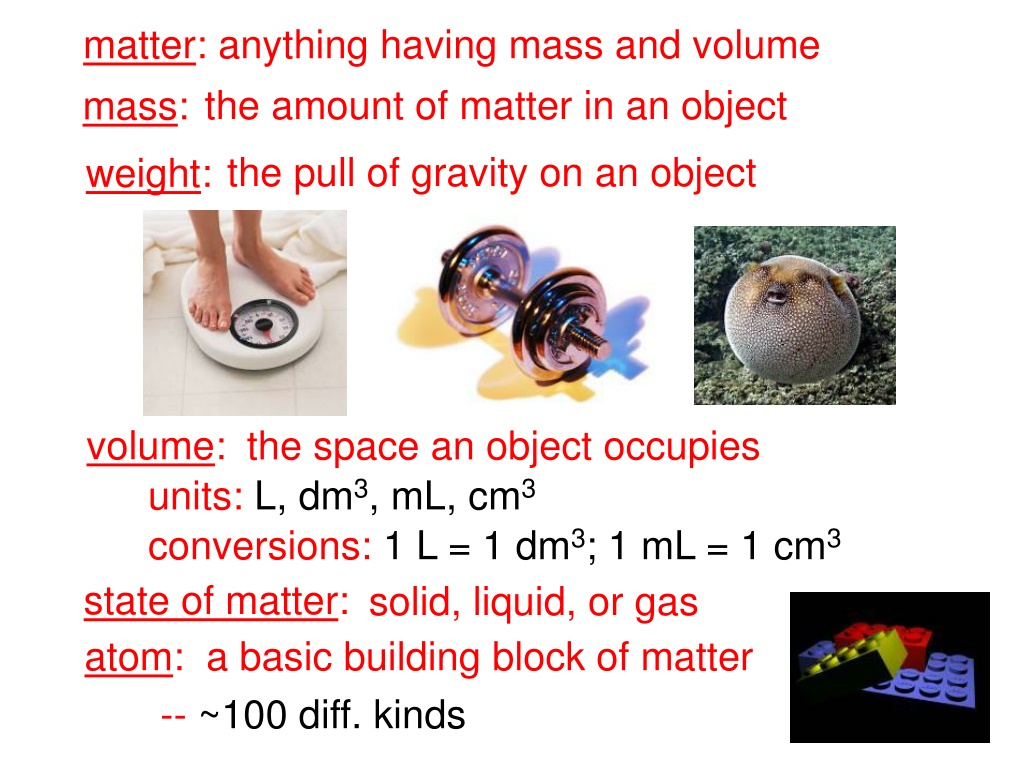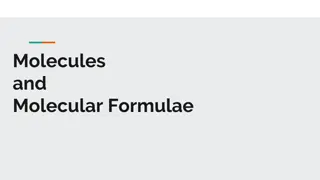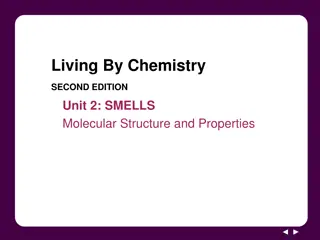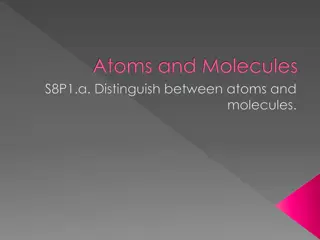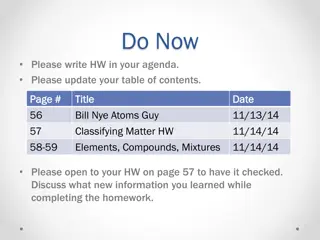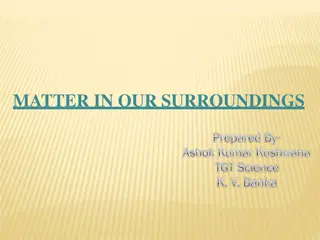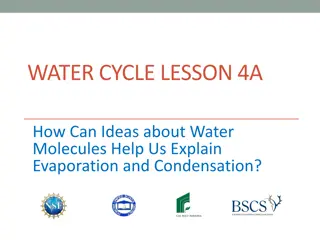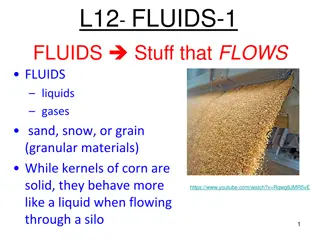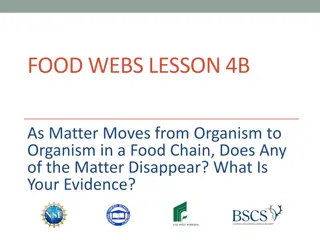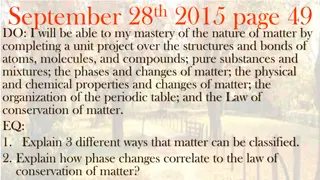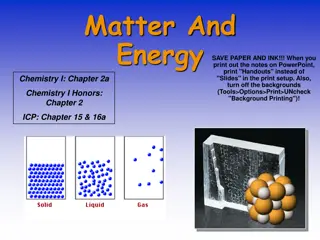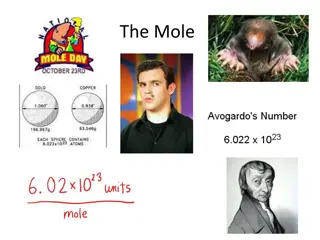Understanding Matter, Elements, and Molecules
Matter is anything with mass and volume, consisting of atoms. Elements are pure substances with one type of atom. Molecules are groups of bonded atoms. The content explains mass, volume, different forms of elements, allotropes, and compound properties like sodium chloride. It covers chemical symbols, states of matter, and different types of atoms in molecules.
Download Presentation

Please find below an Image/Link to download the presentation.
The content on the website is provided AS IS for your information and personal use only. It may not be sold, licensed, or shared on other websites without obtaining consent from the author. Download presentation by click this link. If you encounter any issues during the download, it is possible that the publisher has removed the file from their server.
E N D
Presentation Transcript
matter: anything having mass and volume mass: the amount of matter in an object the pull of gravity on an object weight: volume: units: L, dm3, mL, cm3 conversions: 1 L = 1 dm3; 1 mL = 1 cm3 the space an object occupies state of matter: atom: a basic building block of matter -- ~100 diff. kinds solid, liquid, or gas
Elements contain only one type of atom. (a) monatomic elements consist of unbonded, identical atoms (i.e., in element form, they DON T form m cules) Broken Dreams Blvd. e.g., Fe, Al, Cu, He (b) polyatomic elements consist of several identical atoms bonded together (i.e., in element form, they DO form m cules) H2 O2 Br2 F2 I2 N2 Cl2 -- diatomic elements: 7 7 7 -- others: P4 S8
(c) allotropes: different forms of the same element in the same state of matter OXYGEN CARBON oxygen gas (O2) elemental carbon graphite ozone (O3) buckyball diamond
molecule: a neutral group of bonded atoms Chemical Symbol Description Model O 1 oxygen atom O2 1 oxygen molecule 2 unbonded oxygen atoms 1 phosphorus atom 1 phosphorus molecule 4 unbonded phosphorus atoms 2 O P P4 4 P Elements may consist of either molecules or unbonded atoms.
2 He 4.003 Chemical symbols for elements appear on the periodic table; only the first letter is capitalized. 10 Ne 20.180 18 Ar 39.948 36 Kr 83.80 54 Xe 131.29 86 Rn (222) STOP
FINAL THOUGHTS: Matter and the Elements 1. Matter is anything made of atoms. Weight is a measure of the pull of gravity on a mass. Volume is the amount of space a sample of matter occupies. 2. Elements are samples of matter that contain only one type of atom. Most are monatomic; the HOBrFINCls are diatomic; P and S are polyatomic. 3. A molecule is any neutral group of bonded atoms. Those atoms may be of the same type, or they may be of different types. H2 O2 Br2 F2 I2 N2 Cl2 P4 S8
Compounds contain two or more different types of atoms. -- have properties that differ from those of their constituent elements e.g., Na (sodium): Cl2 (chlorine): explodes in water poisonous gas table salt (NaCl)
Compound Composition All samples of a given compound have the same composition by mass. Every sample of NaCl tastes the same, melts at the same temp., and is 39.3% Na and 60.7% Cl by mass.
A 550. g sample of chromium(III) oxide (Cr2O3) has 376 g Cr. How many grams of Cr and O are in a 212 g sample of Cr2O3? 376 g Cr 68.4% Cr and 31.6% O % Cr = 550 g (New sample has same composition.) Cr: O: 212 g (0.684) = 145 g Cr 212 g (0.316) = 67 g O chromium(III) oxide
composition: what the matter is made of water: many threesomes of 2 H s and 1 O copper: many Cu atoms Properties e.g., what it looks like, smells like, how it behaves describe the matter. Chemistry tries to relate the microscopic and macroscopic worlds.
FINAL THOUGHTS: Compounds 1. Compounds have two or more types of atoms strongly bonded together in an unvarying ratio. It is for this reason that all samples of a given compound have the same composition and intensive properties. 2. The properties of compounds can t necessarily be predicted based on the properties of their constituent elements. 3. Chemistry connects the macroscopic world of empirical observation with the microscopic (or molecular, or atomic, or subatomic) world. This is done by the creation, analysis, and use of models.
States of Matter LIQUID SOLID ( ( ) ) GAS ( ( ) ) ( ( ) ) ( ( ) ) ( ( ) ) ( ( ) ) ( ( ) ) ( ( ) ) ( ( ) ) ( ( ) ) ( ( ) ) ( ( ) ) ( ( ) ) ( ( ) ) ( ( ) ) translating; close together translating quickly; far apart vibrating vapor: the gaseous state of a substance that generally is found as a solid or liquid
Changes in State Energy put into system: sublimation melting boiling SOLID LIQUID GAS freezing condensation deposition Energy removed from system:
FINAL THOUGHTS: Compounds 1. Compounds have two or more types of atoms strongly bonded together in an unvarying ratio. It is for this reason that all samples of a given compound have the same composition and intensive properties. 2. The properties of compounds can t necessarily be predicted based on the properties of their constituent elements. 3. Chemistry connects the macroscopic world of empirical observation with the microscopic (or molecular, or atomic, or subatomic) world. This is done by the creation, analysis, and use of models.
Classifying Matter (Pure) Substances have a fixed composition and fixed properties. -- they have a single chemical formula ELEMENTS e.g., Fe, N2, S8, U COMPOUNDS e.g., H2O, NaCl, HNO3 Image:Sulfur.jpg sulfur (S8) sodium chloride (NaCl)
Mixtures contain two or more substances mixed together. -- have varying composition and varying properties -- The substances are NOT chemically bonded; they retain their individual properties. Tea, orange juice, oceans, and air are mixtures.
Two Types of Mixtures homogeneous: (or solution) sample has same composition and properties throughout; evenly mixed at the particle level e.g., salt water Kool Aid alloy: a homogeneous mixture of metals e.g., bronze (Cu + Sn) pewter (Pb + Sn) brass (Cu + Zn)
Two Types of Mixtures (cont.) heterogeneous: different composition and properties in the same sample; unevenly mixed tossed salad e.g., raisin bran suspension: settles over time e.g., paint snow globes
Chart for Classifying Matter MATTER MIXTURE (PURE) SUBSTANCE ELEMENT COMPOUND HETEROGENEOUS HOMOGENEOUS STOP
Separating Mixtures involves physical means, or physical changes. -- No chemical reactions are needed because substances are NOT bonded. 1. sorting: by color, shape, texture, etc. 2. filtration: by particle size filtrate: the portion of a mixture that passes through a filter
Separating Mixtures (cont.) 3. magnetism: one substance must contain iron some substances dissolve more easily than others 4. chromatography: analyte: any substance you are investigating eluent: the solvent in column chromatography paper chromatography column chromatography
Separating Mixtures (cont.) 5. density: sink vs. float ; perhaps use a centrifuge blood after high- speed centrifuging decant: to pour off the liquid
6. distillation: different boiling points (i.e., different vapor Separating Mixtures (cont.) thermometer water out (warmer) pressures) water in (cooler) more-volatile substance (i.e., the one with the lower boiling point) mixture more-volatile substance, now condensed heat source Volatile substances evaporate easily.
FINAL THOUGHTS: Compounds 1. Compounds have two or more types of atoms strongly bonded together in an unvarying ratio. It is for this reason that all samples of a given compound have the same composition and intensive properties. 2. The properties of compounds can t necessarily be predicted based on the properties of their constituent elements. 3. Chemistry connects the macroscopic world of empirical observation with the microscopic (or molecular, or atomic, or subatomic) world. This is done by the creation, analysis, and use of models.
Properties of Matter ONE OF THESE CHEMICAL properties tell how a substance reacts with other substances. PHYSICAL properties can be observed without chemically changing the substance. AND ONE OF THESE EXTENSIVE properties depend on the amount of substance present. INTENSIVE properties do NOT depend on the amount of substance.
Examples: P, I electrical conductivity P, I ductile: can be drawn (pulled) into wire .. malleable: can be hammered into shape P, I C, I reactivity with water ... P, I brittleness . P, I magnetism
Density how tightly packed the particles are mass m = D Density = volume V ** Density of water = The density of a liquid or solid is nearly constant, no matter the sample s temperature. Density of gases is highly dependent on temperature. 1.0 g/mL = 1.0 g/cm3 A student needs 15.0 g of ethanol, which has a density of 0.789 g/mL. What volume of ethanol is needed? m m 15.0 g D = V = = = 19.0 mL V D 0.789 g/mL STOP
FINAL THOUGHTS: Compounds 1. Compounds have two or more types of atoms strongly bonded together in an unvarying ratio. It is for this reason that all samples of a given compound have the same composition and intensive properties. 2. The properties of compounds can t necessarily be predicted based on the properties of their constituent elements. 3. Chemistry connects the macroscopic world of empirical observation with the microscopic (or molecular, or atomic, or subatomic) world. This is done by the creation, analysis, and use of models.
SI SI Prefixes Prefixes to to Memorize Memorize Prefix Symbol Meaning giga- mega- kilo- deci- centi- milli- micro- nano- pico- femto- G M k d c m n p f 109 106 103 10 1 10 2 10 3 10 6 10 9 10 12 10 15 That s a fact, That s a fact, Jack! Jack!
G M k d c m n p iga ega ilo eci enti illi icro ano ico emto Got my kilt, Dad! Can t miss 109 106 103 10 1 10 2 10 3 10 6 10 9 10 12 10 15 idsummer s no- pants Friday! f STOP
Significant Figures: Is a digit significant? All non-zeroes are significant. Zeroes might or might not be. Use the box-and-dot method to determine the sig figs in a given quantity. ? 1. Identify the leftmost AND rightmost non-zeroes. 2. Draw a box around these AND everything in-between. 3. Everything in the box is significant. 4. Zeroes on the box s LEFT are NOT significant. 5. If there is a decimal point ANYWHERE, the zeroes on the box s RIGHT ARE significant. Otherwise, no.
0 . 0 9 4 4 3 3 8 0 . 0 0 . 0 0 3 2 1 2 2 0 0 0 5 1 2 4 . 0 0 6 1 3 0 0 . 4 0 3 0 . 0 0 3 0 4 0 . 0 2 5 0 3 In scientific notation, the exponent has no effect on the number of sig. figs. 1 . 4 0 x 109 3 5 . 0 6 x 10 3 3 7 . 1 2 0 x 105 4 7.2 x 105 7 2 0 x 103 2 STOP
Rules: Significant Figures and Mathematical Operations 1. When multiplying or dividing, the answer must have the same number of sig. figs. as does the quantity with the fewest sig. figs. .. 1.52 C 3.431 s = 0.443 C/s .. 0.0251 N x 4.62 m 3.7 s = 0.031 N.m/s 2. When adding or subtracting, the answer must be rounded to the place value of the least precise quantity. 2.53 s + 117.4 s = 119.9 s 2.11 m + 104.056 m + 0.1205 m = 106.29 m
3. Because conversion factors are exact numbers, they do NOT affect the # of sig. figs. Your answer should have the same # of sig. figs. as does the quantity you start with.
FINAL THOUGHTS: Compounds 1. Compounds have two or more types of atoms strongly bonded together in an unvarying ratio. It is for this reason that all samples of a given compound have the same composition and intensive properties. 2. The properties of compounds can t necessarily be predicted based on the properties of their constituent elements. 3. Chemistry connects the macroscopic world of empirical observation with the microscopic (or molecular, or atomic, or subatomic) world. This is done by the creation, analysis, and use of models.
Conversion Factors and Unit Cancellation For the rectangular solid: L = 14.2 cm W = 8.6 cm H = 21.5 cm Find volume. V = L . W . H = (14.2 cm)(8.6 cm)(21.5 cm) = 2600 cm3
Convert to mm3. 2600 cm3( ) 3= 2,600,000 mm3 ______ 1 cm 10 mm = 2.6 x 106 mm3 10 mm and cm differ by a factor of . mm2 cm2 . 100 mm3 cm3 . 1000 STOP
